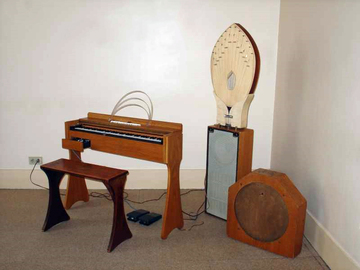ondes Martenot
|
Invented in
1928 by French radio serviceman Maurice Martenot, the ondes Martenot uses the
variable frequency of oscillation in vacuum tubes to produce notes. The right
hand is used to play notes, either by moving a metal ring to left (low pitch)
or right (high pitch) or by playing a keyboard (which could be moved left to
right to produce vibrato), while the left hand handles a small drawer
containing a glass control button for loudness and attack (much like a cello’s
bow - Martenot was a cellist) and flipswitches to change the instrument’s
timbre.
|
prime example
the story
Though probably
better known in the rerecorded 1972 version, the original recording of Jacques
Brel’s Ne Me Quitte Pas features a piano and an ondes Martenot, played by
Sylvette Allart. Allart recorded her own versions of music by Bach, Händel and
other composers using the ondes Martenot and also played on two other songs by
Brel, 1962’s Le Plat Pays and 1963’s La Fanette.
Brel wrote this classic song after his mistress, actress and singer Suzanne ‘Zizou’ Gabriello, threw him out. She was pregnant with his child, but he refused to acknowledge it as his own. As a result, their relationship ended and Zizou had an abortion. Brel was later quoted as saying it is not a love song, but rather a song about the cowardice of men.
Brel wrote this classic song after his mistress, actress and singer Suzanne ‘Zizou’ Gabriello, threw him out. She was pregnant with his child, but he refused to acknowledge it as his own. As a result, their relationship ended and Zizou had an abortion. Brel was later quoted as saying it is not a love song, but rather a song about the cowardice of men.
other examples
In 1937,
French composer Olivier Messiaen was commissioned for a piece to accompany
shows with light and water, which were displayed in Paris on the Seine every
night during the International World Fair. He wrote Fête Des Belles Eaux, a
composition for an ensemble of six ondes Martenots. From then on, Messiaen
would use the instrument in more of his compositions.
Radiohead’s Johnny Greenwood discovered the ondes Martenot through the work of Messiaen: “The first time that I heard the ondes Martenot I was fifteen years old, it was in a recording of the Turangalîla-Symphonie by Messiaen. The sublime sound of the ondes carried the violins out into the space. Since that day, I’ve been obsessed with the ondes.” Since he was nervous about performing with his original 1983 ondes Martenot and since production of the instrument had stopped in 1988, he asked Analogue Systems to build him a replica, so in 2001 the French Connection was born. Since then, Greenwood has used the instrument on all of Radiohead’s as well as his solo albums (How To Disappear Completely from 2000’s Kid A uses an ondes Martenot throughout) and even composed a piece for the ondes Martenot, called Smear. “The best way to describe it is a very accurate theremin that you have far more control of.”
Radiohead’s Johnny Greenwood discovered the ondes Martenot through the work of Messiaen: “The first time that I heard the ondes Martenot I was fifteen years old, it was in a recording of the Turangalîla-Symphonie by Messiaen. The sublime sound of the ondes carried the violins out into the space. Since that day, I’ve been obsessed with the ondes.” Since he was nervous about performing with his original 1983 ondes Martenot and since production of the instrument had stopped in 1988, he asked Analogue Systems to build him a replica, so in 2001 the French Connection was born. Since then, Greenwood has used the instrument on all of Radiohead’s as well as his solo albums (How To Disappear Completely from 2000’s Kid A uses an ondes Martenot throughout) and even composed a piece for the ondes Martenot, called Smear. “The best way to describe it is a very accurate theremin that you have far more control of.”

